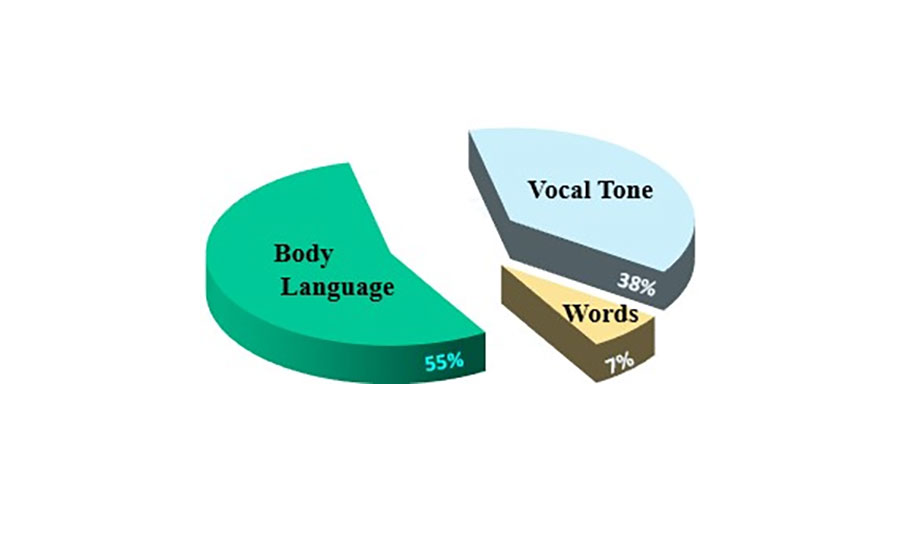Supervisors generally are in a unique position, serving as the link between management and the workforce. Successful execution of organizational strategy hinges on the effectiveness of the supervisor's ability to lead workers to enthusiastically engage in their assigned tasks. The supervisor must be able to effectively communicate in order to achieve this. The supervisors must also be able to communicate with peers and management if they are to add value to the operation. Upper management would be well served to offer supervisors a working as well as enhanced knowledge of effective communication skills.
The most common means of communication among people is speech and language. Language expresses inner thoughts and emotions, makes sense of complex and abstract thought, enabling interaction. Language is made up of words that have meaning; therefore, care should be taken in their selection. It is generally better to use familiar words in place of unfamiliar ones, concrete words in place of abstract ones, short words in place of long ones, and single words in place of several. For most people, effective communication means a proficient use of language. For communication to occur, both sender and receiver must have a common language with similar understanding of the meaning of the words.
Interpersonal communication
Communication starts with one person having a thought and wanting to communicate it to another. The person (sender) has to put it into words (encode) and transmit it to the other person (receiver). See figure 1. The receiver then has to decode the message and make sense of it which depends on his life experience, the situation, listening ability, and context in which the exchange occurs. Therefore, the better the sender knows and understands the receiver, the greater is the potential for successful communication.
There are many communication channels: oral (face-to-face) or in groups, by telephone or radio, in written form — by e-mail, letters, handouts, postings on bulletin boards, or signage. Selecting the appropriate channel for the situation will impact the quality of the exchange. On a construction site, much of the communication is generally done verbally, and so the environment where the exchange occurs will impact the quality of the exchange.

Image credit: Peter Furst
Nonverbal communication
People have engaged in nonverbal communication for much longer than they have been using language. The main reason is that much of nonverbal communication takes place below our conscious awareness level. Generally, all verbal communication has a nonverbal component, which may reinforce, detract from, or contradict the message’s intent. The nonverbal component typically communicates belief, attitude, or emotional aspects of the message. Its effect increases or diminishes by the relationship or state of mind of those involved.
Gestures are sometimes used to reinforce a statement, may indicate direction, approval, dislike, disappointment, or anger. Facial expressions and posture also are strong indicators of what a person is feeling or thinking, whether they are fearful, agitated, conciliatory, or some other emotion. Any of the nonverbal cues can play an important role in either facilitating or hindering effective communication, or provide valuable information about the thinking of the people involved in the exchange.
Another important factor for which the sender should be looking is feedback from the receiver of the message, especially body language and tone of voice. This will allow the sender to make adjustments so that the message is received and interpreted as intended and understood by the receiver. So being aware of this and taking it into consideration will greatly improve the exchange of information.
The supervisor may not be fully aware of the importance of nonverbal communication and its impact when dealing with people in everyday work-related situations. This could create barriers to the effective exchange of information and understanding by rendering the supervisor less than optimally effective. Research has shown that about 7 percent of information is communicated by words, 55 percent by body language, and 38 percent by vocal tone (see Figure 2).
It is important to note that, in positive interactions, we do not seem to focus as much on the tone of voice or nonverbal component of the interaction but on what is being said and how the message makes us feel. When the exchange is negative, emotionally charged, or confrontational, the focus tends to gravitate more heavily to the nonverbal part of the interaction, with body language, facial expression, and tone of voice taking on a significant role in how we react to the message.
The effect of nonverbal communication
Facial expressions
Facial expressions play a significant role in communication, as it conveys the emotional state of an individual to an observer. Eye contact is considered an important aspect of interpersonal communication in some cultures and has a different implication in others. Such things as blinking rate can be used to assess whether or not a person is nervous or possibly may be lying.
Postures
Posture also pays a role in nonverbal communication, folded arms or crossed legs may signal defensiveness or concern, while an open posture may portray friendliness and positivity. Leaning toward a speaker signals interest in what is being said. Mirroring (copying the other person's posture) helps to subtly develop a connection. Paying attention to posture will improve communication.
Gestures
A motion of the hand, head, or body can express or emphasize an idea or emotion and heighten the interest of the listeners. Research has found when gestures and words are aligned, the message is more effective, but when they are not aligned, they tend to confuse the listener and detract from the message.
Tone of voice
Tone of voice conveys emotions (excitement, enthusiasm, humor, etc.) and our attitude, whether we send a message of humor, anger, sarcasm, jealousy, or sincerity. Tone pertains to pitch, volume, pace, and emphasis used in delivering a message. Pitch of voice (intensity, degree of high and low) and its timing also play a role in the quality of the communication. When tone is varied, life and energy are injected into the message.
People respond instinctively to voice tone, either positively or negatively. This might actually be more important than what is literally being said. The same sentence can have different meaning depending on which word is emphasized and the tone of voice used. Though the messages delivered may not seem offensive, the tone of voice used may make it hurtful which impacts the outcome of the exchange. Research indicates that people make instinctive judgment of others based upon the tone used.
The tone is often perceived as reflecting the speaker's attitude toward the recipient. A statement that may seem neutral on paper can become very offensive if spoken with a sarcastic or demeaning tone of voice, and unlikely the intended message is heard. People judge those with deeper voices as having more authority, the message carries more weight and tends to garner greater acceptance. To make their message more impactful, supervisors should try to utilize the lower end of their voice ranges.
Other factors
Speaking slower has a positive effect on communication. When you slow down, the implied message is that you are thinking, weighing the evidence and giving careful consideration to your message. It is important to slow down when giving advice, coaching, or providing constructive criticism. So, the person who pauses and speaks at a slower pace tends to be perceived as more intelligent, thoughtful, and deliberate.
The relationship between people involved in communicating may form a greater barrier to the effectiveness of the process than almost any other cause. Lack of empathy can also create a barrier. Better messages can be transmitted if one can see oneself in the other's place and analyze the intended message from their point of view. When communication is ineffective, one needs to look first at the nature of these relationships rather than at ways of improving communication. The potential benefits of the effort can enhance working relationships as well as benefit the organization.
Verbal feedback is an important part of the communication process informing the sender if the receiver has understood the message as the sender intended. Besides the words, the tone of voice provides information on their emotional reaction. The sender must also observe the receiver's other nonverbal ques to assess their reaction in order to make adjustments so as to enhance the recipient's understanding of the message.
Effective verbal communication strategies
- Focus on issues, not people. Avoid taking things personally. Try to resolve issues amicably. Express needs and/or opinions in terms of the work and not the worker's personality.
- Empathize and demonstrate sensitivity rather than being judgmental. How one feels will easily manifest itself in one's demeanor and will readily be picked up by others.
- Create an atmosphere of openness to establish good working relationships. Always give your undivided attention when conversing. Avoid noisy areas.
- Avoid pulling rank. Be genuine and straightforward. Treat people fairly and with respect.
- Demonstrate flexibility and respond in ways that acknowledges other’s knowledge and experience. Thank them for their input.
- Actively listen and show a genuine interest are attributes of a successful communicator. This creates an atmosphere of trust and respect, enhancing communication and problem resolution.
- Be concise, use clear language, listen for feedback, and pay attention to body language and tone of voice.
Conclusion
We become better communicators to the extent that we can devise messages that elicit the response we expect or desire from recipients. To accomplish this effectively, we need to thoroughly understand the communication process and its inherent barriers. If we do not elicit the anticipated response, we need to be able to modify the message to facilitate its understanding. Douglas McGregor, a leading authority on management practices, once said, “It is a fairly safe generalization that difficulties in communication within an organization are more often than not, mere symptoms of underlying difficulties in relationships between parties involved.



